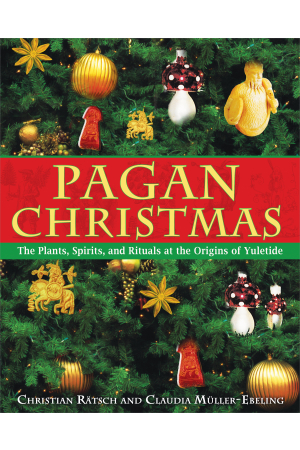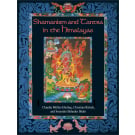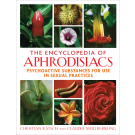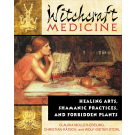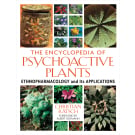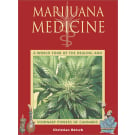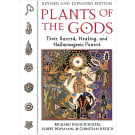Pagan Christmas
The Plants, Spirits, and Rituals at the Origins of Yuletide
- Pages: 224
- Book Size: 8 x 10
- ISBN-13: 9781594770920
- Imprint: Inner Traditions
- On Sale Date: October 24, 2006
- Format: Paperback Book
- Illustrations: 156 color and 40 b&w illustrations
• Analyzes the symbolism of the many plants associated with Christmas
• Reveals the shamanic rituals that are at the heart of the Christmas celebration
The day on which many commemorate the birth of Christ has its origins in pagan rituals that center on tree worship, agriculture, magic, and social exchange. But Christmas is no ordinary folk observance. It is an evolving feast that over the centuries has absorbed elements from cultures all over the world--practices that give plants and plant spirits pride of place. In fact, the symbolic use of plants at Christmas effectively transforms the modern-day living room into a place of shamanic ritual.
Christian Rätsch and Claudia Müller-Ebeling show how the ancient meaning of the botanical elements of Christmas provides a unique view of the religion that existed in Europe before the introduction of Christianity. The fir tree was originally revered as the sacred World Tree in northern Europe. When the church was unable to drive the tree cult out of people’s consciousness, it incorporated the fir tree by dedicating it to the Christ child. Father Christmas in his red-and-white suit, who flies through the sky in a sleigh drawn by reindeer, has his mythological roots in the shamanic reindeer-herding tribes of arctic Europe and Siberia. These northern shamans used the hallucinogenic fly agaric mushroom, which is red and white, to make their soul flights to the other world. Apples, which figure heavily in Christmas baking, are symbols of the sun god Apollo, so they find a natural place at winter solstice celebrations of the return of the sun. In fact, the authors contend that the emphasis of Christmas on green plants and the promise of the return of life in the dead of winter is just an adaptation of the pagan winter solstice celebration.
From the Shamanic World Tree to the Christmas Tree
Father Christmas--An Anthropomorphic Fly Agaric Mushroom?
Perceptive people have associated St. Nicholas with the fly agaric mushroom that, in former times, was eaten during the winter solstice in northern Europe--and which made it possible to fly through other worlds.
--NAUWALD 2002, 37F
Many aspects of modern Christmas rituals have their origin in pagan customs. At close inspection, even the red-and-white dressed Father Christmas can be seen as another version of Wotan or as a secret shaman. But most astonishingly, he might even be seen as an anthropomorphic fly agaric mushroom! A scandalous claim? Perhaps. But first, let us look more closely at his connection with the shamanic fly agaric mushroom.
The Fly Agaric Mushroom (Amanita muscaria)
The characteristic red mushroom with its white dots is the Nordic shamanic drug par excellence. Most shamans of the Northern Hemisphere ate it ritually. Its shamanic use can be traced to the Lapps, the Siberian nomadic peoples (Samojeden, Ostjaken, Tungusen, and Jakuten), and the North American Indians.
Old Nordic Shamanism was associated closely with Odin (Wotan) and resembled the shamanism of the Lapps and the ancient Finnish peoples. In many mythologies, storm and thunderstorm gods are associated with the fly agaric mushroom, perhaps because the thunder and lightning of the outer world can be triggered by the agaric mushroom flight through the inner world.
The Germanic thunder and fertility god, Donar or Thor, drives his goat cart through the air. He causes thunder and lightning when he throws his hammer in the clouds. Then thunderstones (meteorites) begin falling and hitting the earth. Where they inseminate the ground, mushrooms grow, especially fly agarics.
Mythology recorded in modern times contains some stories in which Wotan (Wodan or Odin), the shamanic god of ecstasy and knowledge, was associated with the fly agaric mushroom. According to legend, the fly agaric mushroom grows where Wotan rides on his horse through the clouds with his followers, the members of the wild hunt, in the dark nights around the time of the winter solstice. Wherever the froth of Wotan’s horse fell to the ground, the ground would become “pregnant” and nine months later would sprout fly agaric mushrooms, at the time of the autumn equinox. The story sometimes says that the fly agaric mushrooms grow from a mixture of the blood (red) and froth (white) of Wotan’s white horse. The wild hunt is drawn to the mushroom, calmed and put in a good mood with incense. In the smoke columns of the incense, and wherever it finds nourishment, the wild hunt army becomes guardian of house and farm.
The ethnic cultures that live in the north of Kamchatka (a peninsula in the far northeast of Siberia), especially the Tschuktschen and Korjaken, live as reindeer nomads and wander with their flocks in the vast plains of that country. They and other north Siberian shamans ritually ingest the fly agaric mushroom, especially when they want to communicate with the souls of their ancestors or make contact with the spirits for divination and to heal the sick.
Reindeer, Sleighs, and Shamans
The feeling of flying that occurs after consumption [of fly agaric mushrooms] is an effect that could be the origin of the Scandinavian and English version of Father Christmas, who flies through the air on his reindeer sleigh.
--BREMNESS 1994, 286
The idea of a great variety of reindeer sleighs flying through the air at Christmastime seems to be pervasive. A laughing, red-and-white Father Christmas sits in his sleigh with his sack, his rod, and the presents. Every year this ancient shaman comes down to Earth in his reindeer sleigh and lands on numerous roofs--the very image of a great, twinkling, lit-up, Christmas decoration.
Father Christmas is a pagan shaman from the grey mist of a distant European past. This might seem strange to a lot of people in our day; they may even think that this is an extremely far-fetched claim. Can you prove something like that?
--Appleton 2002, 53
Siberian mythology describes a “heavenly hunt” in a manner similar to the Germanic wild hunt. The Siberian shamans ride on reindeer sleighs through the air, up to the clouds. The world tree is their goal; this is where the magic reindeer are. The Siberian Tschutschuken say that the moon is a man on a sleigh that is pulled by two reindeer to Earth and can fly back up to heaven--just like our Father Christmas (Guter 1978, 57ff). The association of reindeer and shamanism is ancient. In the caves of the Ardèche are wall paintings of reindeer that are around thirty thousand years old. As early as the Old Stone Age, reindeer were sunk in moors as sacrificial offerings--for example, in the Hamburg steppe of Meiendorf and Stellmoor and in Magdalénien (Pohlhausen 1953). This is the ritual context of cultic poles or stakes crowned with anthropomorphic mushrooms with dwarf caps. Sometimes, even reindeer skulls were placed on top of such sacrificial stakes. These often-neglected details may be early associations of the reindeer with the godly mushrooms, just as the mushroom-topped ritual poles may be early ancestors of the Christmas tree. So the red-and-white Father Christmas, riding on his reindeer sleigh through the air, clearly was nothing other than an anthropomorphic fly agaric mushroom or a fly agaric mushroom shaman.
Preface
The Ethnobotany of Christmas
Traditions, Rituals, and Customs
Christmas Songs of the Hard Winter
A Pagan Feast
Red and White: Colors of Christmas
The Darkness of Midwinter
Sacred Nights, Smudging Nights, and Incense
Wotan and the Wild Hunt
From the Shamanic World Tree to the Christmas Tree
Christmas Trees
Holy Trees
St. Nicholas and His Little Helper, Ruprecht
Baccy Claus: The Smoking Christmas Man
Father Christmas: An Anthropomorphic Fly Agaric Mushroom?
Christmas Tree Decorations
The Golden Apples
Miracle Blossoms for the Winter Solstice
St. Barbara’s Boughs
Christ Rose or Hellebore
Christmas Roses
Christmas Stars
Exotic Christmas Flowers
Christmas Greens
The Old Ones of the Woods
Mistletoe: Winter Woods Green
Holly: Frau Holle’s Holy Tree
Laurel: The Sun God’s Plant
Ivy: Tendrils of the Maenads
The Aromas of Christmas: A Shower of Pheromones
Incense for the Holy Nights
Incense Under the Christmas Tree
Incense Recipes for the Smudging Nights
Christmas Intoxications and Other Delights
Yule Drinking
Love on Christmas Eve?
Chocolate Father Christmas: Ritual Christmas Cannibalism
Mugwort, the Sacrificial Goose, and the Christmas Roast
Rosemary and the Yule Boar
Merry Christmas from Mother Coca, Coca-Cola, and Santa Claus
Christmas Spices and Christmas Baking
Anise and St. Andrew’s Night
Saffron: Red Gold for Christmas
Christmas Baking
The Rebirth of the Sun
Sun Gods: Apollo, Mithras, and Jesus
Mystery Cults
Kyphi: Incense for the Smudging Nights
Saturn, the God of Incense
The Erotic Bean Feast
New Year’s Eve: The Wild Feast of Sylvester
Protection and Fertility Rites
Lucky Plants
Happy New Year
Thunder and Witch Flour
From Incense to Fireworks
Lucky Mushrooms and Chimney Sweeps
New Year’s Day
Magical, Shamanic Clover
The Night of Befana, the Christmas Witch
Holy Bushes that Protect Against Witches
Paradise Plant
Devil’s Dirt and Witches’ Smoke
Three Kings Day: The End of the Christmas Season
The Pagan Magi from the East
Frankincense, the Secret of Old Arabia
Bibliography
Index
Lee Prosser, Ghostvillage.com, Dec 2006
"The illustrations and photographs are excellent. The text is concise, and accurate. Pagan Christmas is a fine reading experience!"
Lee Prosser, Ghostvillage.com, Dec 18, 2006
The day on which many commemorate the birth of Christ has its origins in pagan rituals that center on tree worship, agriculture, magic, and social exchange. But Christmas is no ordinary folk observance. It is an evolving feast that over the centuries has absorbed elements from cultures all over the world--practices that give the magical properties of plants and plant spirits pride of place. In fact, the symbolic use of plants at Christmas effectively transforms the modern-day living room into a place of shamanic ritual.
Christian Rätsch and Claudia Müller-Ebeling show how the ancient meaning and use of the botanical elements of Christmas provide a unique view of the religion that existed in Europe before the introduction of Christianity. The fir tree was originally revered as the sacred World Tree in northern Europe. When the Christian church was unable to drive the tree cult out of people’s consciousness, it incorporated the fir tree by dedicating it to the Christ child. Father Christmas in his red-and-white suit, who flies through the sky in a sleigh drawn by reindeer, has his mythological roots in the shamanic reindeer-herding tribes of arctic Europe and Siberia. These northern shamans used the hallucinogenic fly agaric mushroom, which is red and white, to make their soul flights to the other world. Apples, which figure heavily in Christmas baking, are symbols of the sun god Apollo, so they find a natural place at winter solstice celebrations of the return of the sun. Indeed, the emphasis at Christmas on green plants and the promise of the return of life in the dead of winter is by its very nature another form of the pagan winter solstice celebration still practiced today.
CHRISTIAN RÄTSCH, Ph.D. (1957 – 2022), was a world-renowned anthropologist and ethnopharmacologist who specialized in the shamanic uses of plants. He is the author of The Encyclopedia of Psychoactive Plants and Marijuana Medicine, and coauthor of Plants of the Gods, Shamanism and Tantra in the Himalayas, and Witchcraft Medicine. He lived in Hamburg, Germany, and lectured around the world. CLAUDIA MÜLLER-EBELING, Ph.D., is an art historian and anthropologist and coauthor, with Christian Rätsch, of Shamanism and Tantra in the Himalayas and Witchcraft Medicine. She lives in Hamburg, Germany.



